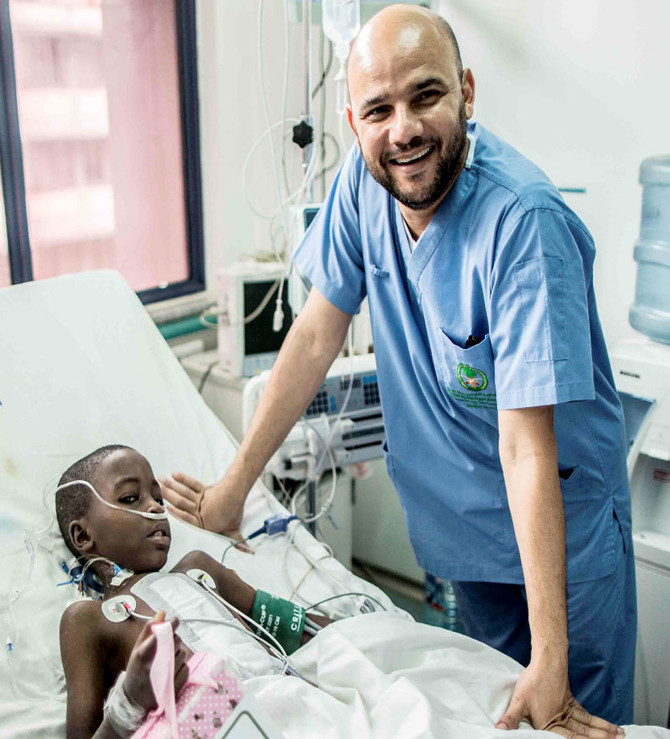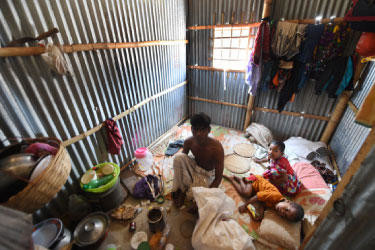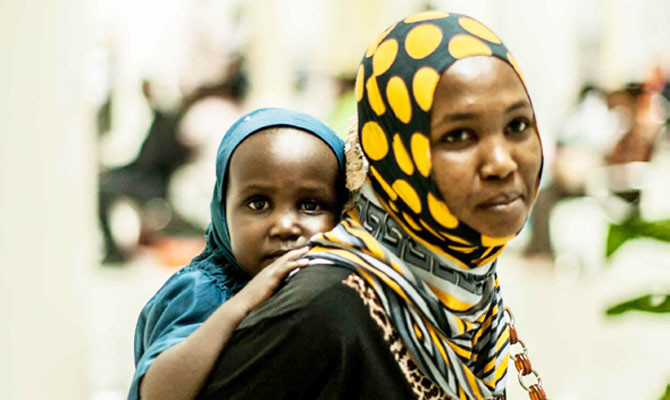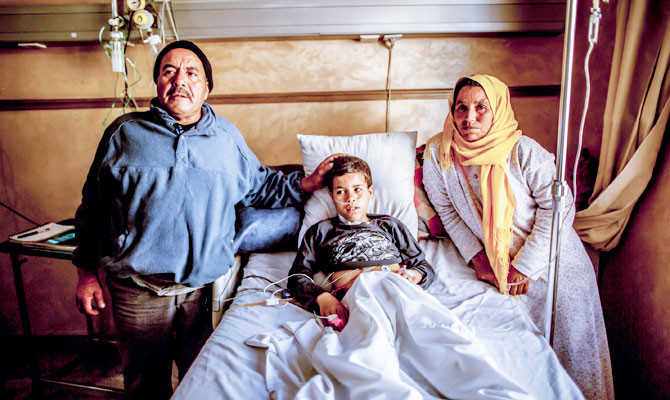SWITZERLAND: It’s a simple gesture, but it can help to break a world record — and mend hearts. Little Hearts is a project that gives impoverished children with congenital heart disease (CHD) access to life-saving treatment, thanks in large part to philanthropists from Saudi Arabia. To continue doing its good work, it is aiming to gain international recognition by launching a Guinness World Record attempt to create the largest-ever online photo gallery. Little Hearts is asking people across the globe to submit a picture of themselves making a hand-to-heart gesture to raise awareness of CHD — caused by a problem in the structure of the heart — and vital funds toward the projects’ goals.
“The Guinness World record itself is to get 60,000 photos of individuals making the heart gesture, which just fits perfectly with the campaign, as every heart deserves to beat,” said Reza Malik, fund-raising officer for Little Hearts. “We want to set ourselves a target of a year.”
The Little Hearts project provides free life-saving cardiac surgery and interventional cardiac catheterization for children with congenital heart defects from underprivileged families irrespective of gender, race or religion.
Each year more than a million babies worldwide are born with CHD; 100,000 of them will not live to see their first birthday and thousands more will die before they reach adulthood. “The majority of these who do survive beyond the first year of life will live in pain unless they live in the developed world where they have access to health systems,” Malik said. “That is why our ultimate aim is to provide life-saving heart operations to babies born with congenital heart defects in the Third World.
“We have a criteria: Their families are impoverished. There is no chance they can afford the medical operation and treatment required to help these children survive. Congenital heart defects are treatable. We have the solution for it; the issue is that it costs a lot of money.”
A standard CHD operation costs more than SR7,000 ($1,800) per child. “But that is a direct deliverable,” Malik said. “You are instantly saving a life.”
Little Hearts is the flagship project of the global humanitarian charity Muntada Aid, which operates in some of the world’s most vulnerable places, providing assistance to communities affected by disasters, conflicts and poverty.
The organization’s core values are faith-inspired by the Islamic tenets of integrity, transparency, the uplifting of the needy, safeguarding the vulnerable and having a sustainable impact on the world. It was initiated from Saudi Arabia in the form of a trust.
In the past seven years, the Little Hearts project has conducted 27 successful week-long missions, which involve sending an expert team of 30 — including heart surgeons, pediatricians, anesthesiologists and nurses — to developing countries such as Bangladesh, Sudan, Mauritania, Yemen and Tanzania. The teams have performed dozens of free surgeries. At times many of these countries have not had a single heart surgeon who can perform open-heart surgery on babies and small children. The cause of a congenital heart defect — signs and symptoms of which can include rapid breathing, bluish skin, poor weight gain and feeling tired — is often unknown. However, it can be caused by infections during pregnancy such as rubella, the use of certain medications or drugs such as alcohol or tobacco, parents being closely related and poor nutritional status or obesity in the mother. Serious congenital heart defects usually become evident soon after birth or during the first few months of life.
“It (the Little Hearts project) has a 97-per-cent success rate, so it is promising,” Malik explained. “The risk-to-reward ratio is extremely high. But is is not just about saving a life, but about giving the quality of life back to a child that is their basic human right. These babies are often underdeveloped; they cannot run or play like their peers.
“They have a right to their childhood and a right to life itself. By saving a single baby’s life, potentially you have saved up to nine other members of the immediate family, from parents to siblings. Why? Because usually the parents, the siblings, they are all working for the survival of this baby or child. Their world revolves around them. Usually the siblings are out of education; they are forced to earn a living. The mother’s care goes into the focus of that child. These operations turn tears of grief to tears of joy.”
Since its launch in 2011, Little Hearts has saved the lives of more than 1,800 children. Generous donors, he said, are the heart of the project and allow the team to continue their lifesaving work.
Philanthropists from Saudi Arabia have been the most prolific donors. “Initially a lot of the funding for the project, when it was first initiated, was from philanthropists from the Middle East, primarily Saudi Arabia,” Malik said. “Now we want to take this global. We want to take the Little Hearts mission and the cause of children with congenital heart defects and to turn that into a visible, viable issue and concern for the international community — from the UN to governments themselves. “Because it is not a communicable disease like malaria, there is no governmental or UN agenda to resolve the problem itself — to eradicate the disease and reduce the time it takes to provide treatment to these children.
“We know this is a global epidemic; it is one of the most common diseases of the heart in the world. Yet there is no governmental or UN mandate to reduce the rate, whereas we have the treatment — and we have the solutions.”
Malik said that there are two key goals of the Little Hearts project. “The aim is to continue providing the missions to the communities and countries in developing nations where they need that immediate support, because without it the governments are not going to subsidize the costs related to taking these children in these countries to places where they can get access to the treatment they need,” he said.
“The short-term goal is to continue the mission, but with that is the cost of logistics, bringing those facilities to a country on a temporary basis to be able to carry out these operations and then disbanding and moving on.
“This brings us to our second mission, our long-term goal. In the next three years we want to establish five full-time clinics with trained pediatricians and cardiologists who can perform these operations in these countries such as Egypt, Morocco, Mali, Tanzania and Chad.”
Little Hearts already has a dedicated center in Bangladesh, which has been fully operational for a year. A second center is about to be launched in South Africa.
As well as performing life-saving operations, heart surgeons with Little Hearts also run a training program, equipping local doctors with the knowledge to perform the complex procedures.
The goal over the next three years is to increase the impact of the Little Hearts project by increasing capacity in hospitals and cardiac centers in developing nations to be able to provide an international standard of specialist paediatric cardiac intervention, saving the lives of many more babies in Africa, Asia and the Middle East.
Malik hopes the photo campaign will bring the awareness — and encourage the donation of vital funds — to continue and build on the organization’s life-saving work.
“The campaign has two aims; one to raise awareness of the plight of children suffering with congenital heart disease; secondly to give it that platform and visibility on an international stage and among high-level governments and within the United Nations so we can engage and say these are the solutions, now there needs to be action and finances,” he said.
“You can’t expect the general public to be pooling together these resources, because they are not cheap. We know there is funding for public health care infrastructure. Let’s give it its due. Because those 1.4 million children deserve that.”
Dr. Jamal Al-Ata, head surgeon at Little Hearts, said: “Unfortunately, the treatment of heart disease in the developing world is not given proper attention, due to the lack of financial resources and that of trained medical staff. It is important this is overcome.” His words were echoed by Dr. Mansur Al-Mathari, a consultant pediatric cardiologist with the project. “We need your support,” he said. “We need the support of everyone to keep this program running and hopefully we can save a lot of patients’ lives around the world.” The public can upload their entries for the photo campaign at: http://handstohearts.photos/
Project funded mainly by Saudi donors seeks help to save children with heart disease
Project funded mainly by Saudi donors seeks help to save children with heart disease

- The organization’s core values are faith-inspired by the Islamic tenets of integrity, transparency, the uplifting of the needy, safeguarding the vulnerable and having a sustainable impact on the world
- The goal over the next three years is to increase the impact of the Little Hearts project by increasing capacity in hospitals and cardiac centers in developing nations
From Nigeria to Makkah, sereh finds a home on Saudi tables

- The introduction of sereh to Saudi Arabia is believed to be linked to the Hajj pilgrimage, when people from across the world brought with them their cultural traditions, including food
RIYADH: Sereh, a beloved African dish rooted in Nigerian tradition, has carved out a place for itself in the culinary landscape of Saudi Arabia.
Once popular as a street food in Makkah’s older neighborhoods such as Al-Mansour, Al-Hafayer, and Al-Barno, sereh has grown beyond its origins to reflect a story of migration, cultural exchange, and shared taste.

Traditionally, sereh — also known as tsire or suya — consists of skewered beef seasoned with a bold blend of African spices, then roasted over an open flame. This method creates not only a flavorful dish but an aromatic experience that draws people in.
“Tamiz, or Afghani bread, was also a street food, so they were often enjoyed together,” said Rodwan Fallatah, owner of the African restaurant AfriQ in Riyadh.
FASTFACT
Sereh’s journey from West African street stalls to Saudi dinner tables captures the essence of Makkah’s openness.
“You roast the sereh until it’s hot, and with tamiz nearby, you simply grab some hot bread to enjoy with it.”
The dish originates from the Hausa tribe, an ethnic group with a strong presence in northern Nigeria, southern Niger, and beyond.

“As a proud member of the Hausa tribe, I take great pride in seeing our traditional dish being enjoyed far beyond Hausa land, reaching communities across Africa and even here in Saudi Arabia,” said Zainab Hawsawi, a Saudi writer and businesswoman.
She noted that the typical Hausa kitchen is a treasure trove of rich and diverse flavors, featuring meat dishes like dambu nama, delicately shredded and seasoned dried beef; kilishi, thinly sliced, spiced, and sun-dried meat; and balangu, famous for its juicy, freshly grilled pieces.
“But nothing compares to the explosion of flavors you experience when eating suya, especially as you dip each piece into yaji, the signature blend of spicy suya dipping spices,” she added.
The introduction of sereh to Saudi Arabia is believed to be linked to the Hajj pilgrimage, when people from across the world brought with them their cultural traditions, including food.
Sereh gradually integrated into the local food scene, creating a fusion of flavors that captivated the taste buds of residents.
“I think the logical answer would be migration,” said Fallatah, emphasizing how pilgrims helped introduce the dish into Makkah’s multicultural food scene.
Makkah, long regarded as a cultural crossroads, provided fertile ground for this culinary exchange. As locals encountered new dishes, they began to experiment and adapt.
Originally from Madinah, Fallatah moved to Riyadh in 1997 and opened AfriQ, where he serves sereh among other dishes.
His passion for African cuisine has made his restaurant a popular spot for both locals and visitors.
“The spices are unique, and the preparation of sereh is different. Locals observe and learn, and soon they want to try it themselves,” he explained, noting that demand is especially strong in hotels catering to pilgrims and tourists.
Sereh’s journey from West African street stalls to Saudi dinner tables captures the essence of Makkah’s openness and the Kingdom’s growing embrace of cultural diversity through food.
As it continues to evolve, sereh stands as a flavorful reminder of how Saudi kitchens are becoming more globally inspired — one skewer at a time.
Where We Are Going Today: Kermal – Lebanese lounge in Jeddah

- The cherry kebab offers a sweet-savory twist and is worth trying, while the sea bass sayadieh was served with fragrant fish rice topped with fried onions and nuts
Located on Al-Kayyal Street in Jeddah, Kermal welcomes you with soft yellow lighting, a cozy interior and vibrant artwork. This Lebanese lounge blends classic flavors with comfort, creating a modern take on a traditional Beirut home.
The menu features lots of familiar favorites and a few standouts. We started with the creamy chicken mushroom soup, which was rich and satisfying, served with toast and a squeeze of lemon.
The rocaa salad with beetroot was fresh and tangy and made for a simple and pleasant starter. Other appetizers include the shrimp fatteh, which had a crispy, creamy tang thanks to the house salsa and the grape leaves and fried potato cubes with yogurt, which were also very tasty.
For mains, the Kermal mixed grill, including juicy lamb chops, tender kebabs and well-seasoned shish tawook served with grilled vegetables, tahini and garlic sauce, was a highlight. Priced at SR135 ($36) it is a generous platter for sharing.
The cherry kebab offers a sweet-savory twist and is worth trying, while the sea bass sayadieh was served with fragrant fish rice topped with fried onions and nuts.
For dessert, the kashta booza made a refreshing finish — creamy and fragrant with a pistachio crunch. Drinks like the pink mojito and raspberry cooler were sweet and enjoyable.
Kermal also has a breakfast menu and lunch deals for options throughout the day. Visit Instagram @kermal.sa for more details.
Opinion: Tackling childhood obesity starts at home

DHAHRAN: Here, Dr. Hanan Al-Shaikh discusses child obesity in a mini opinion piece for Arab News. Al-Shaikh is chair of the Women and Children’s Health Department at Johns Hopkins Aramco Healthcare in Saudi Arabia.
The received wisdom about the causes of obesity is that genetics has the strongest influence. This seems to provide comfort to parents of large children: It’s not my fault; it’s written in their DNA.
This is nonsense. Children are not born obese; obesity is induced by their environment. Yes, a child’s genetics can make them more susceptible to overeating, but are they the ones buying the food and cooking the meals?
Sorry, parents, but it is time to take responsibility for your children’s waistlines. You and you alone have the strongest influence on whether your children become overweight or obese. You choose what they eat and determine how much they exercise. Your own choices around diet and physical exertion set the example they will follow.
A recent forecast published in leading medical journal The Lancet suggests that Saudi Arabia will have one of the highest child obesity rates in the world by 2050. Separate research suggests that obesity costs the country almost $227 billion a year.
It is human nature to seek excuses for big problems by focusing on factors outside of one’s control. Yes, genetics plays a role in obesity. No, we cannot stop our children from seeing billboards advertising fried chicken buckets. Yes, the heat makes it harder to exercise outdoors for many months of the year.
It is also human nature to confer responsibility for big problems on others, particularly the state. The government needs to crack down on fast food advertising, encourage schools to raise physical activity levels, and so on.
These things may be true. But most of us retain the absolute power to choose what we eat and how much we exercise – even if we pretend we do not – and many factors are well within our control.
One of these is the role that parents have in teaching their children how to eat and exercise in their earliest years. Nothing influences a young child more than the actions of their parents, and roughly speaking, the first seven years of a child’s life are crucial for instilling lifelong habits for healthy eating and exercise.
Once a child becomes overweight or obese, it is incredibly hard for them to shed the weight. Some obese children may need surgery; most will need months, if not years, of treatment. The burden on the child, the parents, and the healthcare system is huge. Prevention rather than intervention is key.
Sadly, some kids who visit the paediatric wellness clinic at our hospital tell us they get as many as eight hours of screen time per day, eat chocolate and popcorn for lunch, and drink more than a can of soda daily. These are terrible habits that will almost certainly cross over into their adult lives.
It is time for parents to stop blaming influences outside their control and, instead, play a leading role in the fight against child obesity.
Saudi Arabia makes space for freelancers to thrive in culinary sector

- Culinary Commission’s latest move is ‘a dream come true’ for chefs
JEDDAH: Saudi Arabia’s Culinary Arts Commission has launched a freelance license for chefs via the Abde’a Cultural Licenses Platform.
The commission’s CEO, Mayada Badr, told Arab News: “The freelance chef license is a major milestone in empowering Saudi culinary talent, as it is opening the door for chefs to innovate and succeed independently while contributing to the Kingdom’s culinary sector.”

Abde’a, an e-platform developed to strengthen partnerships with the private sector, is operated under the umbrella of the Ministry of Culture.
The newly introduced license will enable Saudi nationals aged 18 and above — and who hold certified culinary training and valid food safety or health certifications — to legally provide freelance culinary services, paving the way for wider freelance opportunities in diverse venues and events across the Kingdom.
The freelance chef license is a major milestone in empowering Saudi culinary talent, as it is opening the door for chefs to innovate and succeed independently while contributing to the Kingdom’s culinary sector.
Mayada Badr, Saudi Culinary Arts Commission CEO
The initiative will “support skill development and career growth in the sector, as well as recognition and credibility by reinforcing adherence to professional standards in the culinary field,” according to a statement.
Chef Rawan Al-Harthi, a Jeddah-based pastry chef, said: “This license gives us the freedom to showcase our culinary identity while working independently and legally. It’s a dream come true for chefs who want to grow their brand without being tied to a restaurant.”
Another chef, Faisal Al-Malki, echoed Al-Harthi’s sentiments. “Being recognized as a licensed freelance chef adds value to our profession and pushes us to raise the bar in terms of quality and creativity,” he said.
The launch of this initiative “underscores the commission’s commitment to expanding opportunities for local culinary talent, while fostering a culture of creativity and professionalism,” a press release stated.
Where We Are Going Today: ‘Liu Chong Qing Hot Pot’ – Chinese restaurant in Riyadh

- Refreshing fruits and traditional Chinese tea are served at the end of the meal, which rounds out the experience beautifully
If you’re seeking an affordable yet delightful hot pot experience, Liu Chong Qing Hot Pot in Riyadh is a must-try. This renowned Chinese restaurant chain specializes in Sichuan-style hot pot and boasts over 500 locations worldwide, making it a favorite among hot pot enthusiasts.
The restaurant offers both spicy and mild broth, catering to a range of preferences. But the broth is just the beginning; the open buffet is truly the highlight. Guests can choose from a vast array of fresh ingredients, including shrimp, crab, lettuce, salmon, tuna, and various types of mushrooms. This buffet style allows you to pick exactly what you want, ensuring a personalized dining experience.
Once you’ve gathered your ingredients, you can return to your table, where raw beef awaits. One of the best parts of the experience is cooking the beef to your liking. You can choose how you want it done — whether rare, medium, or well-done — adding a layer of customization to your meal. It’s exciting to watch the raw meat sizzle in the hot pot. You can wrap the cooked beef in lettuce or enjoy it on its own, perhaps with a side of rice.
Refreshing fruits and traditional Chinese tea are served at the end of the meal, which rounds out the experience beautifully. The restaurant’s location in the vibrant Hittin district of the Saudi capital adds to its appeal, ensuring a lively atmosphere that enhances the dining experience.
The branch in Riyadh is huge and boasts a corner that allows visitors to try traditional Chinese outfits and take pictures.
From the variety of ingredients to the enjoyable cooking process, Liu Chong Qing delivers a satisfying hot pot experience that’s both fun and delicious.






















